

Native Alternatives to Bush Honeysuckles
Terry Bonace
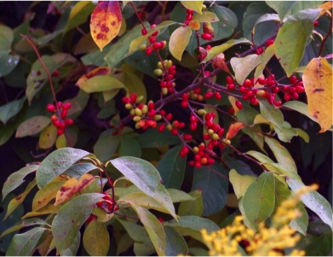
Bush honeysuckles are an aggressive invader that crowd out desirable native species. But they were introduced for a reason. They are easy to grow, grow rapidly, and replant after removal. They have flowers and berries that are attractive to birds and butterflies. Fortunately, however, a number of native species grow well in the dunes and provide similar benefits for wildlife.
Spicebush (Lindera benzoin) is a good native alternative to bush honeysuckles. Spicebush is common in the Beverly Shores, particularly in the woodlands on either side of Kemel Road. You will also find abundant spicebush alongside most trails in the Indiana Dunes State Park. Spicebush has small fragrant yellow flowers in the spring, bright red, spicy smelling berries (used for seasoning by European settlers) in late summer and bright yellow leaves in the autumn. The shrub tolerates part shade quite well and obviously, from its local abundance, is well adapted to our dunes habitat. The only requirement for obtaining those beautiful berries is to grow both male and female plants, as spicebush shrubs have two sexes (Some species of plants feature both sexes on the same individual and some on separate individuals).
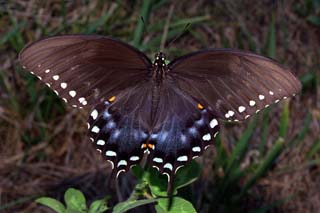
The berries are a good food source for many birds and the beautiful spicebush swallowtail caterpillar (photo above) feed on the leaves. (The beautiful spicebush swallowtail, seen above, is quite common and likely graces all of our yards in the summer.) Spicebush is available from a number of mail order nurseries.
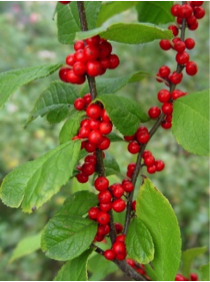
Winterberry (Ilex verticillata) is another shrub with beautiful red berries. These berries grow in clusters close along the twig stems. Indeed, the stems are so showy that they are often sold as Christmas decorations. In Beverly Shores, winterberry, a native species of holly that does not retain its leaves in the winter, is easily located in the fall by its brilliant red berries. You will find it along Beverly Drive growing close to the water. Though it is found in the wild in wetlands, it does not require wet feet to grow as an ornamental. It does, however, like spicebush, come in male and female plants and needs at least one male per 12 female plants to produce berries. Though many cultivars of winterberry are available at nurseries, e.g. “berry poppins,” “berry heavy,”, your best choice for Beverly Shores would be a simple Ilex verticillata to avoid hybridizing these varieties with the native species.

The American black elderberry (Sambucus canadensis) is another Beverly Shores resident, abundant along our roadsides, especially in wet areas. It has white umbrella-like clusters of flowers in early summer and deep purple berries, very popular with birds, later in the season. The leaves, unlike spice bush and winterberry, are “compound” and therefore have multiple leaves arranged around a single stem. This plant is very easy to grow. Its cousin, red elderberry (Sambucus racemosa) is less common, growing more often in woodlands. It is more shade tolerant and produces flowers and bright red berries in more of a cluster than an umbrella. Elderberry fruits, besides being very attractive to birds and pollinating insects, can make delicious jams, pies and even wine. Though the fruit of elderberries is edible, it must be cooked before consumption because it is slightly toxic when raw (so slightly toxic that I have picked fruit off the shrub and eaten it fresh on many occasions before researching for this article). Elderberry flowers are also used both for their flavor (at a Swedish restaurant recently I was offered elderflower-infused aquavit) and medicinal properties.
Highbush blueberry (Vaccinium corymbosum) is a native shrub that does not produce showy fruit but does have beautiful, bright red fall foliage. A nursery dealer says that it “provides four seasons of fanfare, starting with twisted, peeling stems in winter; profuse white or pink blossoms in spring; savory blue fruit in summer; and long-lasting foliage the color of a rich red wine in fall.” Though this may overstate its charms a little, it can be a very handsome plant with outstanding autumn color. It is also the same blueberry used for cultivation of fruit, though in many different hybrid forms, so one could attempt a harvest. If fruit is your motivation for planting, however, keep in mind that male and female plants are needed and you will have competition with wildlife in gathering ripe fruit.
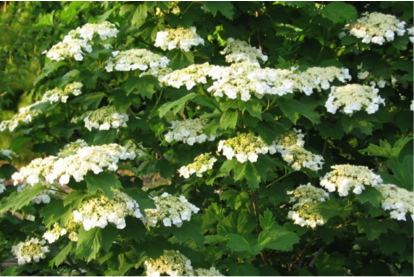
“Highbush” is a popular name for shrubs. Highbush cranberry (Viburnum trilobum), not actually a “cranberry” as you can tell by the scientific name but rather a viburnum, is a popular and easy to grow native shrub. This plant is called “cranberry” because of its bright red berries, borne in umbrella-like clusters. The berries are edible and rich in vitamin C though quite tart, so you might prefer to leave them for birds and other wildlife who will not feel the need to add sugar. These berries are preceded by an umbrella-like arrangement of white flowers, with inconspicuous fertile flowers in the center surrounded by sterile and showy white flowers. The leaves are opposite each other on the stem, resemble a maple leaf and have a nice red fall color.
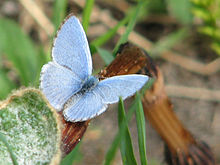
The spring azure, one of those tiny, blue butterflies you might sometimes catch a glimpse of, uses viburnum and blueberries for its host plant. Be careful though when shopping to avoid European highbush cranberry (Viburnum opulus), also frequently planted and available from nurseries. European highbush cranberry is an invasive in many parts of North America, including northwest Indiana. If you see something like a highbush cranberry growing around Beverly Shores, it is more likely to be the European species.
As always, the Environmental Restoration Group (ERG) will be glad to help identify plants for you and make suggestions for native replacements. Don’t hesitate to contact Terry Bonace (tbonace@gmail.com), Hans Lagoni (hlagoni@comcast.net ) or Bill Schaudt (blschaudt2@gmail.com) for assistance.